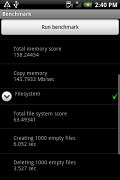Samsung I5700 Galaxy Spica review: Stars serving Eclairs
Stars serving Eclairs
Android, the TouchWizzard
The Samsung I5700 Galaxy Spica is the first Android handset to have a taste of the Samsung home-brewed TouchWiz UI. Tweaking up a few parts of the interface in terms of both functionality and looks, it’s a pretty decent first try.


The TouchWiz UI running on top of Android 2.1
The changes start from the homescreen where up to nine panes are available to fill up with widgets. Unlike the HTC Sense, you don’t have to use all the screens all the time so if you don’t need that many deleting the extra ones will speed up the navigation.

Up to nine panes can be added to the homescreen
Another cool extra of the Samsung I5700 Galaxy Spica is the option to set any of your (currently active) homescreens as the default one (that would be the one to always go back to by pressing the home key). Besides, you can easily rearrange the whole screens, instead of having to move the widgets around.
Samsung have also added 6 widgets of their own, available under “Samsung widgets” when adding content to your homescreen. Those include three different clocks (analogue, digital and a dual digital, showing two time zones at the same time), an internet widget holding a few bookmarks, Memo widget, which enables quick notes and a photo frame. Those hardly contribute a great deal to usability but they are still nice to have at hand.
Next, the Galaxy Spica has four buttons docked on the bottom of its homescreen typical TouchWiz style. They give you quick access to the dial pad, messaging, phonebook and web browser. Those move to the top when you open the main menu and are thus always visible. You are free to rearrange the four icons but removing them or replacing them with others isn’t an option.



The four buttons leading to dial pad, messaging, phonebook and web browser are always at hand
The main menu has also been modified and now consists of side-scrollable panes, much like the homescreen, instead of a vertical scrollable grid. A new pane is added automatically each time the existing ones fill up. Again nine panes is the maximum you can have.
Additionally, the Samsung I5700 Galaxy Spica packs the updates brought by Android 2.1, like several new widgets. There’s no sign of the Live wallpapers and you will have to root the phone and install an additional homescreen app to enable them. Unfortunately, users report their performance is not that good so it's not really worth the fuss.
The new Android version and the TouchWiz overlay aside, two of the key assets of the Galaxy Spica platform have remained unchanged. The Task switcher and the notification area look exactly the same as in the previous versions. Get this right, we are not complaining here – those are just great to have around and really boost the Android experience.


The notification area and the Task switcher are still here
The general user experience provided by the Samsung I5700 Galaxy Spica running on Android 2.1 is pretty good, but the generally inconsistent performance is a pretty big issue at this stage. Apparently the handset is pretty well prepared hardware-wise (you can see the benchmark results below) but the software needs quite some further optimization.
Some of the apps are fine even at this stage and the interface is pretty snappy but exceptions like the camera and the gallery are too great to overlook. We will speak about that in more detail later in the review, but those tend to lag much more often than we would have liked.
If we had to guess we would say that the low amount of RAM (rumored 128MB) doesn’t allow much stuff to be cached and so needs to be loaded every time.
And now for the promised benchmark results. As you can see from the screenshots below the Galaxy Spica has just about the performance that you can expect from an 800 MHz CPU. In terms of pure computing power, it ranks well above of the 600 MHz HTC Legend but falls short of the 1GHz Snapdragon inside the XPERIA X10.




Sony Ericsson XPERIA X10 benchmarks




Samsung I5700 Galaxy Spica benchmarks
The graphics performance however tells a different story with the Galaxy Spica coming second to the Legend but having a comfortable lead over the XPERIA X10. The resolution also counts here with the Sony Ericsson handset needing to refresh almost triple the number of pixels of the Spica but the results of the Samsung are still pretty pleasing.
To get an even better idea of the Samsung I5700 Galaxy Spica performance you can check out the video below.
Reader comments
- AnonD-744806
- 15 Mar 2018
- f}m
Please tell me how to unlock the gt15700 say
- Anonymous
- 11 Dec 2012
- 3MR
there is already an update to 2.2.3 available since august 2012.. google for it.
- clive
- 16 Dec 2011
- f3R
just want to know where & how can I upgrade this phone to vision 2.1 .I have 1yr using this phone but bluetooth is not working course of its vision 1.5 .I will appreciate ur help






